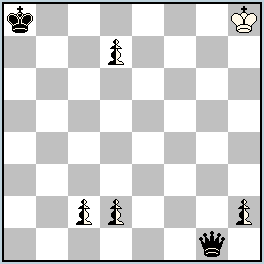| No.289 János Mikitovics (Hungary) |
Original Problems, Julia’s Fairies – 2013 (I): January – April →Previous ; →Next ; →List 2013(I) Please send your original fairy problems to: julia@juliasfairies.com |
 No.289 – János Mikitovics – AUW in non-standard form!
No.289 – János Mikitovics – AUW in non-standard form!
My gratitude to the author for dedication to the 1st Birthday of juliasfairies.com website! (JV)
Definitions:
KoBul Kings: When a piece (not a pawn) of his own side is captured, a King transforms into a Royal piece of the same type as the captured one. When the King is in the form of any Royal piece and there is a capture of one of the pawns of his own side, he becomes a normal King again. Сaptures are illegal if their result is self-cheсk because of the transformation of the Кings according to KoBul rules. Castling is allowed only if the KoBul King is on his initial square in the form of a normal King and if he has not already moved; however he may already have been transformed. In the case of capture by a King in AntiCirce he is reborn on his initial square and may castle. If the capture is by a King which is in the form of some Royal piece, he is reborn on the initial square of that piece.
Isardam: The moves causing a Madrasi-like paralysis are illegal. This holds right up to the capture of the mated King. This is standard form of Isardam.
|
No.289 János Mikitovics
Hungary
original-02.04.2013
Dedicated to the 1 st Birthday of juliasfairies.com website
April 10, 2013  h=3 (1+2+4)
b) nPc2→c7 3 solutions KoBul Kings Isardam Solution: (click to show/hide)
|



I fail to see how this could work. Please, could someone comment at least one solution, what happens there?
E. g. in final position of a) white royal queen attacks two neutral queens. So any move of black leads to illegal madrasi paralysis.
All right, but then also the last move is already illegal as it leads to mutual attack of white and neutral queens, i.e. paralysis not allowed in Isardam. Why is that possible?
Seemingly, the computer applies Madrasi for a Kobul Royal piece, but not only concerning the ‘observed’ pieces of the same type. When a Kobul Royal piece is paralysing two pieces, the whole board is paralysed??????
I must admit that’s best that can I understand without a very good explanation.
When white to move all neutral pieces act as white. So no paralysis here. You can find the same logic in Fide Album 01-03 G208.
It is not possible to say that with White to move all neutral pieces act as white. If this was truth, white could not capture neutral pieces. Rather it is important to stick to definition. It says, that neutral piece can be moved and captured by both white and black.
Therefore mutual observation of wQ and nQ means total paralysis wQ (as nQ could capture wQ if played by black and wQ could capture bQ) and partial paralysis of nQ (white could move it, black cannot). In any case there is paralysis.
So FA0103 G208 is OK in my view. Both half-paralysed mating nNs are paralysed for Black, they cannot move away, but still give check to bK as White can move them.
In any case it just underlines there is paralysis involved and it is a continuous phenomenon, independent of whose move it is.
What paralyses bQ, bK and nPh2?
It seems like in Popeye interpretation only moves that lead to mutual paralysis is forbidden in Isardam.
Kind of related to the “Isardam and en passant” issue discussed on matplus.
One-way paralysis seems to be forbidden in Popeye Isardam too. Let’s try the following position:
Stipulation h=1
White Ga8 Rh4 Bg3 Kf1
Black Pa5 Gh3 Kh1
Without fairy condition, Popeye 4.61 solves it as 1.a5-a4 Ga8-a3 =
But with Condition Isardam added there is no solution, although there is only one, one-way paralysis involved.
So the problem must be somewhere deeper, I think Alex was close to good path with his explanation. It has to have something with the interaction of Isardam, neutral units and royal units inside Popeye engine. But the result is not only counterintuitive, but also not in line with definitions.
It is indeed very interesting that Janos managed to show such intensive and united promotion theme under such strange circumstances.
Just try this position:
Pieces
White Kg3 Pf2 Pg2
Black Ka1
Neutral Pg5
Stipulation h=1
Solution: 1.nPg5-g4 f2-f3 = (Popeye v. 4.59)
So no paralysis on white move for Popeye.
Thanks for bare bone example!
Intuitively, for me this is wrong, as I understand neutrals and paralysis.
Well, any rule can be defined and even it is possible to say “my interaction of fairy elements works as in Popeye x.y”, but without giving details, this seems not to be in line with my neutrals and paralysis understanding.
Just another funny example:
White Kg3 Pf2
Black Ke4
Neutral Pg5
Stipulation h#1
Condition Isardam
2 Solutions
Solution:
1.Ke4-e5 f2-f4 #
1.nPg5-g4 f2-f3 #
I made some tests and now I think that Popeye v. 4.59 can not correctly test problems with Kobul kings and neutral units. Just one example with absurd outcome:
Pieces
White Kc4
Black Ka8 Rh8
Neutral Sb3
Stipulation h=2.5
Condition Kobul kings
Solution:
1…rKc4*b3 [brK=rS] 2.Rh8*a8 [wrK=rS] rSb3-c1 3.Ra8-a2 [wrS=rS] rSc1*a2 =
You can see that where is no logic at all!
My dedication for the anniversary is pointed to the theoretical discussions on Julia’s site. It is an example with a question:
“Is the Popeye’s treatment of Isardam authentic?”
Janos has shown the spectacular possibilities of neutral pieces with “Popeye’s Isardam” – 3xAUW. There is also a trick with Kobulkings in 3 phases.
My example has obvious weaknesses but the same point is present in 6 phases. If Julia adds a diagram, the solvers will be able to solve it.
H#2, 3.1.1.1.; b) nPh7->a2
Condition Isardam
White Ke8 Pf7 Pb3
Black Ke5 Gf5 Na4
Neutral Ph7
A hint, the solution in a) is not 1.Kd4? nPh8=nN 2.nNg6 f8N+
(Julia: I’ve inserted a diagram below)
[img]http://www.ankona.ch/diagrams/100214.png[/img]
H#2, 3.1.1.1.; b) nPh7->a2
Isardam
Thank you, Nikola! I appreciate your comments on the site a lot! But about this problem – should it be published as original? I don’t think it’s a version of No.289, although it’s inspired by it… But it’s up to you and János, of course!
First I congratulate for a beautyful and exciting year of the site – incredible!
Although it is a miniature, I think that my example has too big flaws to be published as an original composition. Extending AUW to 6 pairs of pieces might be a task which would justify the flaws, but not when the conditions like Madrasi or Isardam make it too easy.
Together with Janos’s original (which has no such flaws), my example asks a question – is Popeye’s Isardam a standard interpretation of this condition (concerning the netral pieces) or it could be accepted as a new variant of Isardam?
Perhaps you can publish it as:
Dedicated to JF
(original) example by NP
solution
a) 1.Ke6 nPh8=nS 2.nSg6 f8S#
1.Kd6 nPh8=nB 2.nBg7 f8B#
1.Kf4 nPh8=nG 2.nGd8 f8G#
(1.Kd4? nPh8=nN 2.nNg6 f8N+3.nNc8!)
b) 1.nPa1=nN f8N 2.nNxb3 Nd7#
1.nPa1=nR f8R 2.nRf1 Rxf5#
1.Ke6 f8Q 2.nPa1=nQ Qf6#
If you publish it on a new page, you might add the following original, without so big flaws:
Condition Isardam
White Pd7 Ke1
Black Nd6 Kb5
Neutral Pb2
H#2
b) -bNd6
c) bKb5->e4 (2 solutions)
solution
a) 1.nPb1=nB nBg6 2.Ne8 dxe8B#
b) 1.Ka4 d8Q 2.nPb1=nQ+ Qd1#
c) 1.nPb1=nR+ nRb8 2.Ne8 dxe8R#
1.nPb1=nN nNe7 2.Nc8 dxc8N#
Comment
Some people believe that in the future, the standard chess will regularly have Nightriders instead of Knights. In such case, the problem above would present the Babson task.
This should not be a question, Nikola!
Of course, these versions are your own original problems.
In the example (3+3+1), bN and bG are almost completely artificial and superflouos. I would prefere to avoid their presence on the diagram, saying simply that the promotions to N and G are allowed. But then, bNa4 would be needed to prevent the cooks.
So, I don’t think that it is decent enough to call it the original problem.
It’s also a possibility:
White Ka8 Pf7
Black Ke5
Neutral Pa2
H#2 o-position ( 2 + 1 + 1 ) C+
a) + bPf5 b) nPa2→h3 c) nPa2→h7 2 solutions
Isardam
a) 1.nPa2-a1=nR + f7-f8=R 2.nRa1-f1 Rf8*f5 #
b) 1.nPh3-h2 f7-f8=Q 2.nPh2-h1=nQ Qf8-h8 #
c1) 1.Ke5-e6 nPh7-h8=nS 2.nSh8-g6 f7-f8=S #
c2) 1.Ke5-d6 nPh7-h8=nB 2.nBh8-g7 f7-f8=B #
There are various possibilities for 4×2 without zero position, like:
W:Pc7,Ke1;B:Ka5,Pc2;nPa2;b)Ka5>b2;c)nPa2>e7
W:Pd7,Pe2,Kc1;B:Pg6,Kd4;nPg2;b)rot 180
W:Pd7,Kd6, Pb4,Pe3;bKc4;nPb6,nPf2;b)rot 270(Kf5/Kd6)
Yes, Nikola,
but redundant pawns are here:
V1) the bP in a) & c)
V2) the bP & wPd2 in b)
V3) – the nPb6 & wPb4 in a)
– the nPb3 & wPc4/g5 in b) (3 pawns!!)
Of course, as you see, my version works too without a 0-position:
White Ka8 Pf7
Black Ke5 Pf5
Neutral Pa2
H#2
Isardam
b) nPa2→h3 c) nPa2→h7 2 solutions
I don’t like the 0-p. in general, but I think, here is justified because it ensures the most economical structure.
Janos, put wK in your last version on e8 (or b8,c8,d8) and you will know how I came to the example with bN and bG with 2×3 solutions. Remove bNa4 and wPb3 from that example and there are 3+2 pairs of promotions. Why would we look for 0-position with 5 pieces and only 4 pairs of promotions?
I mentioned those other possibilities without 0-position, especially with rotations, because you perhaps could find some possibility in it which I was not able to see.
0-position with 4 pieces uses the minimum of pieces but nothing more:
Condition Isardam
White Pe7 Kh7;Black Kb7;Neutral Pg7
Zero Move h7 g6;Twin Move b7 c8;Twin Move g7 d3
a) wKh7–>g6 1.Kc7 nPg8=nS 2.nSf6 e8S#/1.Kc6 nPg8=nB 2.nBf7+ e8B#
b) bKb7–>c8 1.Kd7 nPg8=nR 2.Ke6 e8R#
c) nPg7–>d3 1.nPd2 e8Q 2.nPd1=nQ Qd7#
In Popeye 4.59 fairy condition Kobul Kings doesn’t work correctly with neutral pieces. I hope this is corrected in the newest version of Popeye.
In case you need to check Kobul Kings with neutral pieces please use WinChloe.
But Popeye’s gives interesting possibilities because a Kobul King can get some neutral features. Janos nicely showed it in 3 phases.
If Popeye’s approach to the Neatrals could be well defined and consistant, it might be a new type of Isardam.
For example the Popeye 4.62 (py-cvs.exe) can be used …